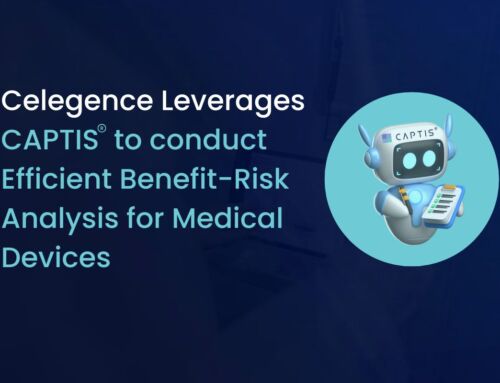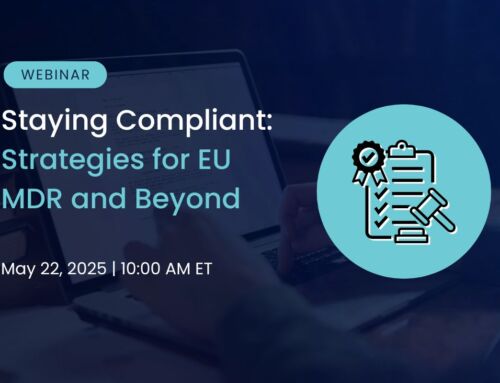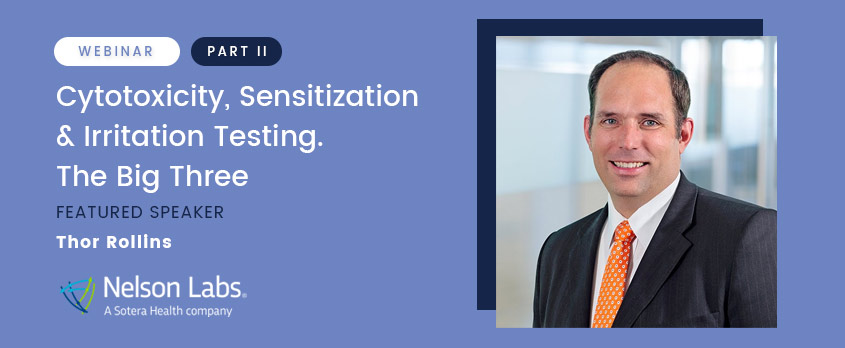
The Big Three: Cytotoxicity, Sensitization & Irritation Testing – Thor Rollins’ Presentation – Part 2
Thor Rollins is a certified microbiologist and specializes in the selection and conduct of in vitro and in vivo biocompatibility tests. He actively speaks on biocompatibility related topics through Nelson Labs external seminars, webinars, and tradeshows. He presented on biocompatibility at the American College of Toxicology annual meeting in 2013 and has published many articles on biocompatibility topics.
He is a participating member on all Association for Advancement of Medical Instrumentation (AAMI) TC 194 and 10993 ISO committees and plays an active role along with the FDA and regulatory committees developing standards, discussing biocompatibility methods, and voting on changes to those standards. As one of a select group of experts in the industry, Thor’s participation on the committees offers him insight on industry changes and helps prepare clients for changes in testing.
During our inaugural Medical Device Virtual Summit – 2021, Thor Rollins of Nelson Laboratories, LLC presented a featured presentation titled “The Big Three: Cytotoxicity, Sensitization & Irritation Testing.”
Why should you watch this video/read the transcript?
This presentation will review the current status of these big 3 tests, what the future holds, and how to problem solve, and the following points:
- An overview of the big 3 tests
- A discussion regarding the updated 10993-1 2018 and the possibility of a big 5
- Current regulatory trends for these tests and what the standard committees are working on
A full transcript of Thor’s presentation is available to download (and to read below) and just press play to watch the clip now.

Claim Your Free EU MDR Checklist Now!
Make sure you and your business are compliant with the new EU MDR. Get our 23 page checklist for actionable technical documentation requirements.
Irritation Testing
The next test we’re going to talk about really quickly is irritation. Irritation is just a quick kind of immediate allergic response from some kind of reaction. So it could be a chemical. It could be detergent, or anything that’s an immediate response. Also, different parts of the body have different sensitivities to these different irritation actions. So, the one most of us run historically for most devices is Intracutaneous. This is extracted just like we do for the cytotoxic tests, but this one’s extracted both in a polar and non-polar extraction. So Ocular and oral, like I mentioned before, injected intracutaneously, so just under the skin looking for irritation.
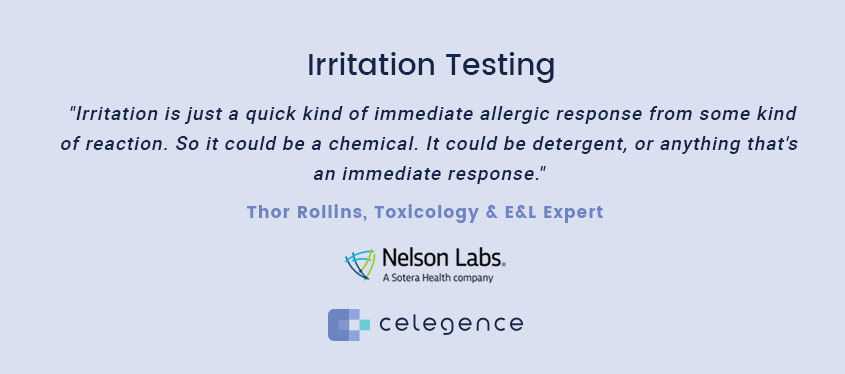
Sensitization
Sensitization is going to look a lot like irritation. Actually, it looks exactly like irritation. You see the same redness and swelling, but the difference is how your body gets there. For irritation, it’s an immediate response based on whatever the contact is with the chemical touch. For sensitization, it’s called delayed hypersensitivity or type 4 hypersensitivity. It’s a cellular based reaction.
So the next time you touch it, you break out the greatest example here that everybody uses, poison Ivy. The first time you contact poison Ivy, nothing happens. You don’t remember. You don’t even realize you touch the plant, but then next time, or the third time you touch it, you break out. So that’s what we’re looking for.
There are historically a couple of test methods that we can run to look for this. It’s Guinea pig sensitization, there’s a Local Lymph Node Assay (LLNA) and the Buehler method. Most everybody today runs the Guinea Pig Maximization.

Claim Your Free EU MDR Checklist Now!
Make sure you and your business are compliant with the new EU MDR. Get our 23 page checklist for actionable technical documentation requirements.
What If I Fail a Test?
I don’t want you guys to think of these tests as checkboxes. Now, I know it’s easier to even do your risk assessment and just say, we’re going to do those three tests. That’s fine. But I want you to understand the standard does want you to evaluate risks. If you’re using a piece of stainless steel or titanium, and you’re having a cleaning validation to show that you’re cleaning every process out there, it’s possible.
They are trying hard to get rid of animal tests, but it’s a lot of work to try to reduce or eliminate these animal tests. And one of main points here is to understand the risks effectively and not automatically jump to an animal test, but if you are going to do the testing, there’s a chance you could fail specifically, like I said, with cytotoxicity.
The first step is just to confirm the procedure, the next is to confirm the results. And this is a little bit easier with cytotoxicity testing because it’s cheaper. But you also don’t want to do just one retest because if you have one pass or one fail that doesn’t really give you anything to go on. So, I always like to do at least three retests. The other thing I’d like to do is break down this device into its components and not just as components, because I want to keep the extraction volume of the finished device, consistent with its components. If the device is made up of four different components, and one of them has 90% of the surface area. I want to make sure that my volume is consistent. So I will put that 90% in the same extraction volume as the finished device and the 5%, 2%, whatever the other three are.
You can also do chemistry. This has been very useful, and this helps with metals. So like I said, metals are a popular source of cytotoxicity, and it’s possible to run an ICPMS or OES looking for metals coming off your device and be able to identify no cytotoxic metals at high levels.
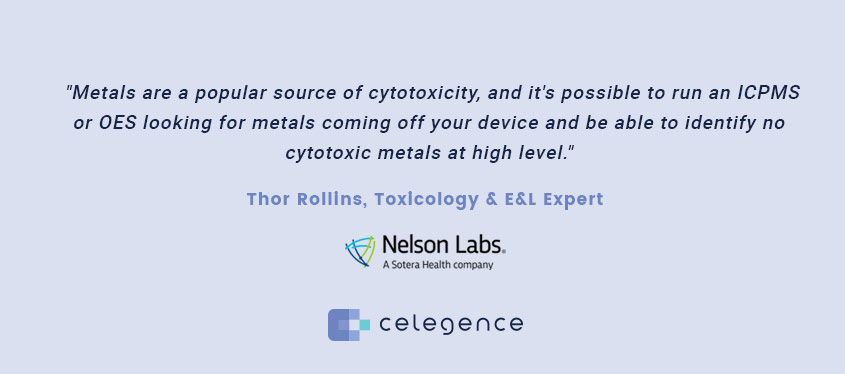
Conclusions on The Big Three: Cytotoxicity, Sensitization & Irritation Testing
I want to just say one last thing, we talked about these tests, what you have to do, and remember they’re not the biological end points you have to assess, right? Don’t think of these as tests and think you have to run there. You have to worry about sensitization, you have to worry about irritation, and you have to worry about cytotoxicity or any of the other biological endpoints you may have based on your device’s use. So, yeah, there’s one way to assess, that is to test them for those endpoints, but you really need to understand the risk of each of these biological endpoints and see if your device has gaps in that risk assessment. And then how are you going to mitigate them? That’s really the approach here. And so, that’s the way the new standards are written and that’s the way the new FDA guidance documents are written. And I know it’s easier to step back on the testing, but we really want to encourage people to start with a risk-based approach.

